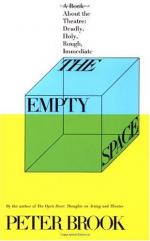|
This section contains 267 words (approx. 1 page at 400 words per page) |

|
The Holy Theatre, part 1 (p 47 to 61) Summary and Analysis
The author begins this essay with the comment that The Holy Theatre "could also be called The Theatre of the Invisible-Made-Visible: the notion that the stage is a place where the invisible can appear has a deep hold on our thoughts". He goes on to suggest that this notion can be found in connection to almost all forms of art (see "Quotes", p. 47), adding that a hunger for some kind of connection to that invisible world/life is one of the reasons why people become audiences to art (not just theatre). Ritual, and by extension art, only works when it nourishingly evokes both aspects of existence (contemporary experience and universal truth). Only then can it can effectively be described as "holy." "Holy" doesn't necessarily mean serious—joy and celebration can...
(read more from the The Holy Theatre, part 1 (p 47 to 61) Summary)
|
This section contains 267 words (approx. 1 page at 400 words per page) |

|




